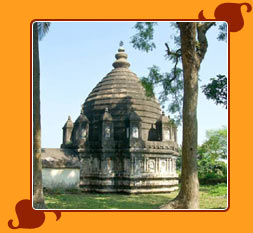Trying to know about Guwahati will tell you that earlier
it was known as Pragjyotishpur (the City of Eastern Light). Having got its
name from two Assamese words, “Guwa”, meaning areca nut and “Haat”,
meaning market, it is positioned in the north eastern state of Assam. Set
amidst the beautiful hills of the eastern borders of the Himalayan mountain
range, Guwahati has in the last few years developed into one of the nicest
tourist destinations in India.

If
you want to know the historical background about Guwahati you will be
charmed to know the facts. There is almost a magic that hovers over the
city. The demon king Narkasura is believed to have constructed this ancient
city. It is also considered to be the ancient ‘Kamrup’, the
birthplace of Kamdeva, the God of Love.
Best Season,
Climate, and Clothing Situated at an altitude of 55 meters above
sea level on the banks of the mighty Brahmaputra, Guwahati experiences an
annual rainfall of 180 cm from May to September. The summer temperatures
range from 22 to 38°C, and in winters the mercury varies from 10 to 25°C.
Guwahati is best visited between the months of October and April. Summers
will require you to carry cotton clothing winters call for woolens. The city
of Guwahati has on offer numerous tourist sites, some religious and some
natural, for the travelers. The following tourist attractions in Guwahati
see the footfalls of several tourists from far and wide all the year round.
Tourist SpotsAssam State Museum :Archaeological
and ethnographic displays are one of the major attractions in Assam's state
museum, situated near the centre of city. The collection includes stone and
copper plate inscriptions dating from the 5th century, a 12th century
sculpture of 'Surya', terracotta pieces and costumes.
Lower down
the hill, the Thongsa Gompa, of Bhutanese Monastery, is the oldest monastery
in the area and was founded in 1692. The present building is not so old -
the original was destroyed by the Gurkhas in their rampage across Sikkim
before the arrival of the British. Zong Dog Palri Fo-Brang Gompa, five km
south of the town centre at the end of the ridge, was built in the mid -
1970s at Durpin Dara Hill and was consecrated by the Dalai Lama. There are
impressive wall paintings in the prayer room, and a rare three dimensional
mandala upstairs. Mountain views are good from Durpin Dara Hill. This area
is a big military camp, but you are free to walk or drive through it.
Umananda
Temple :The Shiva temple of Umananda stands on an island bluff in
the middle of the Brahmaputra. Its location, at the top of a flight of steep
steps up from the beach, is more dramatic than the temple itself. Ferries
and motor launches leave from Umananda Ghat, on the shore between the State
Bank of India and the Ashok Hotel.
Kamakhya Temple:On
the commanding Nilachal hill, overlooking the river 8-km west of the centre,
the important Kali temple of Kamakhya, with its beehive-shaped 'Shikhara',
is a fine example of the distinctive Assamese style of architecture. As one
of the 'Shaktipiths', it marks the place where Sati's 'Yoni' (vulva) landed
when her body fell to earth in 51 pieces, and is one of the three most
important tantric temples in India. A short walk up the hill brings one to a
smaller and emptier temple with great views of Guwahati and the Brahmaputra.
Kamakhya Temple:East of the town centre, atop another
hill, is the atmospheric Navagraha temple popularly known as the "Temple
of the Nine Planets", an ancient seat of astrology and astronomy -
surrounded by large trees that shelter tribes of monkeys. Housed in a single
red dome, again in the beehive style, the central lingam is encircled by a
further nine representing the planets.
.






